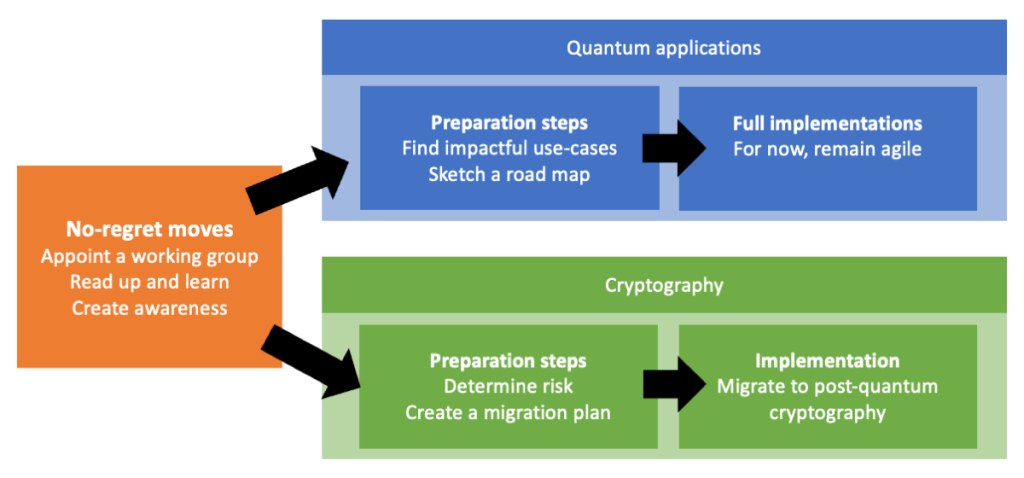The professional’s guide to Quantum Technology
- Preface: Why this guide?
- Part 1 – The background: Why are we so enthusiastic about Quantum Technology?
- Part 2 – The applications: What problems will we solve with Quantum Computers?
- Part 3 – The developments: Searching for a killer application, with a closer look at artificial fertilizer
- Part 4 – The applications of Quantum Networks
- Part 5 – Timelines: When can we expect a useful quantum computer?
- Part 6 – Getting started: What steps should your organization take?
- Part 7 – The hardware: Why you should care about different qubits
- Part 8 – The threat: The impact on cybersecurity
- Part 9 – Scaling up: Why we need error correction
- Further reading: An overview of resources
Part 6 – Getting started:
What steps should your organization take?
In the previous parts, we discussed the use-cases, the threats, and the timelines of quantum technologies. We will now take a more strategic perspective: what concrete steps can we take today? How does one establish a successful road map? Details will greatly differ per organisation and per sector, but as we are in an early phase, we expect that most enterprises will take surprisingly similar approaches during the next couple of years.
Several organisations (especially consultants that would love to support you) have extensive writings on how to get started. Some examples:
- Capgemini – Quantum technologies: How to prepare your organization for a quantum advantage now
- McKinsey – Quantum computing use cases are getting real—what you need to know
- BCG – Quantum Computing Is Becoming Business Ready
We find most of these somewhat ‘hypey’, with a strong emphasis on the risks of missing out and the need to take actions quickly. However, they all mention reasonable strategic steps that organisation can take, which we will lay out below. Let’s break them up into 3 different stages:

1. Start with no-regret moves
Most companies start with early steps aimed at better understanding the situation. These can be done with very little financial risk.
Some must-do actions:
- Appoint a quantum lead, or a quantum working group
- Read up and learn. If you’ve come this far in this Guide, you’re already doing a fantastic job.
- Create internal awareness
Optionally:
- Put quantum on the agenda with senior management.
- Involve collaborators, suppliers and vendors, make your interest in quantum known. It is in your benefit if suppliers are well-prepared.
- Participate in a workshop, hackathon, and other events.
We have a list of interesting learning resources, and an overview of Netherlands-based education opportunities and events.
Very soon, the quantum journey will split into two fairly different categories:
- Preparing for quantum applications, where the goal is to leverage quantum technologies to gain some competitive advantage (for example, by strengthening your R&D, further optimising your logistics, improving a product, etc). For most companies, the main items of interest are the applications of quantum computing.
- Migrating to quantum-safe cryptography, where the goal is to keep your IT secure against attackers with a quantum computer.
It is important to make this distinction, because these categories have different goals and are conventionally addressed by different departments. Let us first look at quantum applications.
Prepare to use quantum applications
2a: Start exploring use-cases
For most businesses, the goal of early, low-regret moves is to be ready to leverage quantum technologies fairly soon after they start offering an advantage.
Must do:
- Find the most impactful use-cases in your area.
- Sketch a road map for the coming years.
Optional but recommended:
- Start concrete explorations, for example by testing and implementing trial use-cases. It is relatively easy (and fun!) to follow the tutorial of programming packages like Qiskit or Cirq.
- Find a partner. Save costs by collaborating on early, pre-competitive exploration.
- Create PR! We notice that many companies are very actively promoting their early results on quantum applications, even if these do not offer significant advantages yet.
- Build a skilled workforce. BCG states: “The biggest challenge may be talent, given the supply constraints. […] Building in-house talent will take time, so it is best to start as soon as possible.
A good exercise is to look at your current needs in high-performance computing. What do you currently spend your computing budgets on? Are there any areas where new tools in computation or modelling could provide serious business value (for example, by being faster, tackling bigger problems, or delivering higher accuracy)? Which quantities would you ideally have calculated, but are beyond the reach of current computers?
Sometimes you rapidly identify use-cases that are not worth further addressing. For example, if today’s computational power is easily sufficient to meet your needs, it’s unlikely that you want to invest in quantum computing for that use case.
R&D partnerships
At Quantum.Amsterdam, we have strong ties to Amsterdam-based research organisations. Offers you might be interested in include:
- Short-term applied research by the Quantum Application Lab, which could lead to a roadmap or a proof-of-concept implementation.
- We invite collaborators to sponsor a PhD or Postdoc researcher at an academic institute, leading to a 2-4 year intensive investigation of a certain use case. There are often subsidies for such public-private partnerships. Our website shows several examples of the past collaborations, and information about starting a new project can be found at the local tech transfer office.
Also see:
- Quantum.Amsterdam meetup “What do companis get out of quantum projects today?” (Youtube)
3a: Implementing actual applications, whenever ready
From here onwards, we find it hard to give concrete advice: goals may depend on your area of business, and on the way that the field of quantum will progress. Other sources will simply tell you do “develop a long-term strategy” or similar.
For inspiration, or a dot on the horizon, you may think towards a competence center for quantum computing, similar to how many companies have special departments for data science and/or AI. It may also be reasonable to combine these departments.
A common advice that we will relay here: the business use of quantum computers is still very uncertain, so at best we can recommend to remain agile!
Migrating to post-quantum cryptography
2b. Prepare for migration to post-quantum cryptography.
Cryptography is a completely different beast, with a more concrete goal, and more urgent timelines for most organizations (here’s why). Luckily, pretty much everyone faces the same problem, making it easier to give concrete guidelines. In essence, anyone who uses modern cryptography should migrate to Post-Quantum Cryptography (PQC) in the next decade. Although standards and regulations are still under construction, there are some urgent steps should be taken well before the migration can start.
We recommend the PQC Migration Handbook (April 2023), written by the Dutch secret service AIVD, and research organisations CWI and TNO.
In general, as a first step, it recommends to:
- Determine the risk and urgency of PQC migration. This likely requires making an inventory of all cryptography in use, and determining how long your data should remain private.
- Create a migration plan.

3b. Migrate
This is a much more technical part, for which you will need a well prepared migration plan. We find it likely that quantum computers might break today’s RSA encryption standard somewhere in the 2030’s, so we stress that such migration should be completed well before that time — taking in to account that IT migrations can take significantly longer than originally planned!
Further questions
Should I have knowledge of quantum mechanics? Should I understand quantum hardware?
When you are tasked with implementing early-stage quantum applications: then yes!
As a strategic manager, or when working on post-quantum cryptography: no.
Do I really need to work on NISQ?
That’s a good question that is hard to answer. We find it unlikely that near-term quantum computers (in the next, say, 1-4 years) will create relevant advantages, although there are plenty of experts who are more optimistic. Future applications will likely differ strongly from the way we ‘program’ quantum computers today, but practising on today’s hardware can grow your understanding and give an edge in experience.
What should I do first: focus on quantum applications or post-quantum cryptography?
For most organisations, the threat to security is more urgent, especially because the migration trajectory can take several years (and this must be completed well before we have large-scale quantum computers!).
However, most organisations work on both trajectories in parallel.
I’m looking for a collaboration – what should I do?
Typically, business developers meet each other at conferences and events, where you may find like-minded partners. We also encourage you to contact us for some sparring on what your organization can do, and to get connected to Netherlands-based knowledge institutes like QuSoft and Quantum Application Lab.




